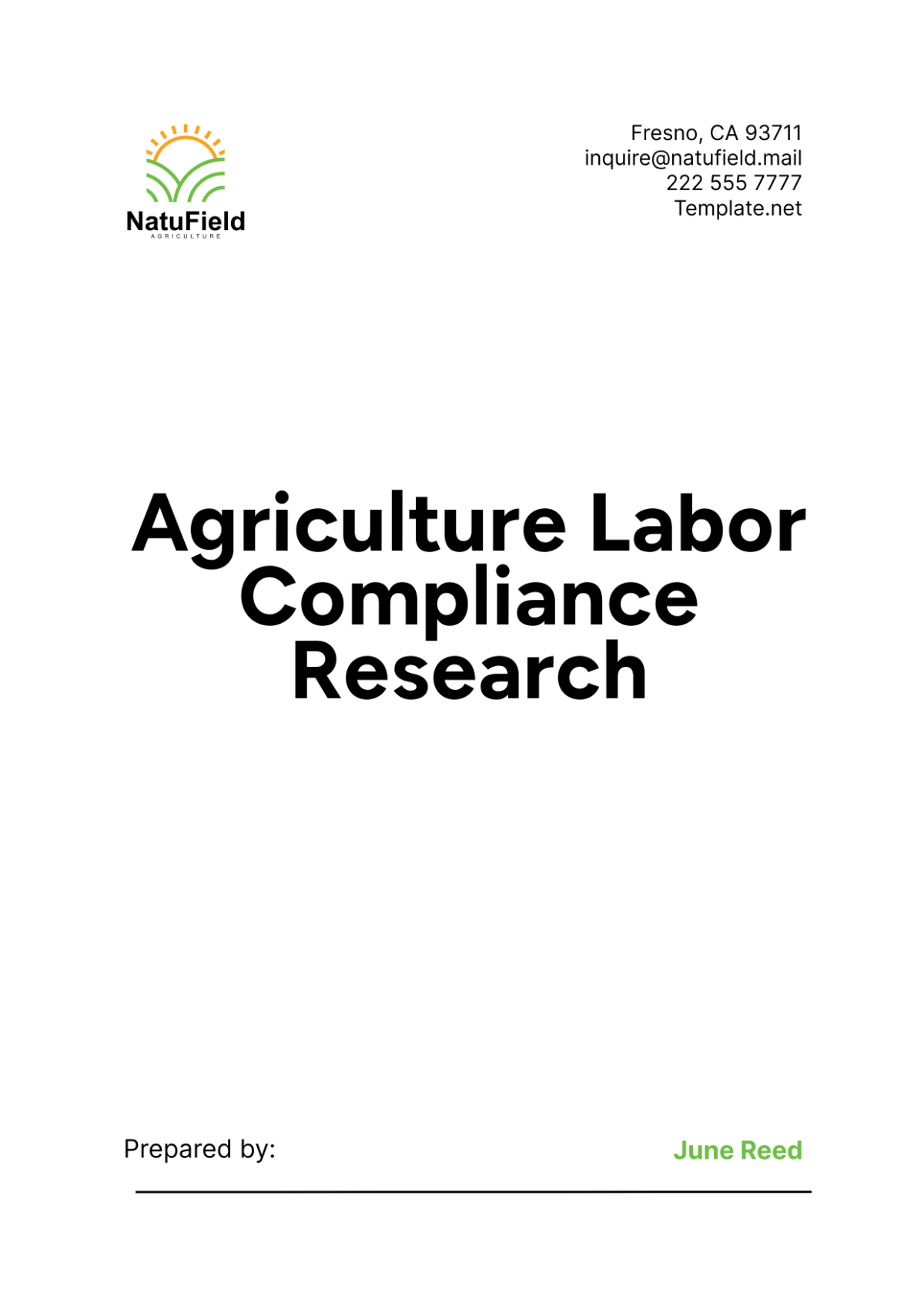Free Agriculture Labor Compliance Research

Introduction
Agricultural labor compliance is a critical aspect of managing agricultural operations, ensuring that labor practices adhere to legal and ethical standards. Compliance with labor laws protects the rights of workers, minimizes legal risks for employers, and promotes a fair and safe working environment. This research report aims to provide a comprehensive analysis of agricultural labor compliance, highlighting key areas of concern, relevant laws and regulations, best practices, and recommendations for [Your Company Name] to enhance compliance and mitigate risks.
1. Overview of Agricultural Labor Laws
1.1 Federal Labor Laws
In the United States, several federal laws govern labor practices in the agricultural sector. Key federal labor laws include:
Fair Labor Standards Act (FLSA):
Establishes minimum wage, overtime pay, record-keeping, and child labor standards.
Provides specific exemptions for agricultural workers, including different minimum wage requirements and overtime exemptions.
Migrant and Seasonal Agricultural Worker Protection Act (MSPA):
Protects migrant and seasonal agricultural workers by establishing employment standards related to wages, housing, transportation, disclosures, and record-keeping.
Requires employers to provide accurate information about working conditions and comply with safety and health standards.
Occupational Safety and Health Act (OSHA):
Ensures safe and healthful working conditions by setting and enforcing standards and providing training, outreach, education, and assistance.
Specific OSHA regulations address hazards unique to agriculture, such as chemical exposures, machinery safety, and field sanitation.
1.2 State Labor Laws
State labor laws vary and may provide additional protections for agricultural workers beyond federal requirements. Key aspects of state labor laws include:
Minimum Wage and Overtime:
Some states have higher minimum wage rates and different overtime requirements compared to federal law.
Employers must comply with the stricter standard, whether federal or state.
Workers' Compensation:
State laws require employers to provide workers' compensation insurance for agricultural workers in case of work-related injuries or illnesses.
Coverage requirements and benefits vary by state.
Child Labor:
States may have more stringent child labor laws than federal standards, regulating the age, hours, and types of work minors can perform in agriculture.
1.3 International Labor Standards
For companies operating internationally, compliance with international labor standards is crucial. Key international labor standards include:
International Labour Organization (ILO) Conventions:
The ILO sets international labor standards through conventions that cover a wide range of labor issues, including minimum wage, working hours, occupational safety, and child labor.
ILO Convention 184 on Safety and Health in Agriculture provides specific guidelines for ensuring safe working conditions in the agricultural sector.
Global Trade Agreements:
Many global trade agreements include labor provisions that require adherence to specific labor standards as a condition of trade.
Companies must ensure compliance with these provisions to avoid penalties and maintain access to international markets.
2. Key Areas of Concern in Agricultural Labor Compliance
2.1 Wage and Hour Compliance
Ensuring compliance with wage and hour laws is a fundamental aspect of labor compliance. Key concerns include:
Minimum Wage Violations:
Paying agricultural workers below the mandated minimum wage.
Failure to provide accurate wage statements or deductions.
Overtime Pay:
Misclassification of workers to avoid paying overtime.
Non-compliance with state-specific overtime requirements.
Record-Keeping:
Inadequate record-keeping practices leading to inaccurate wage and hour records.
Failure to maintain records for the required duration.
2.2 Health and Safety Compliance
Health and safety compliance is critical in preventing workplace injuries and ensuring the well-being of agricultural workers. Key concerns include:
Hazardous Working Conditions:
Exposure to pesticides and other chemicals without proper protective equipment.
Unsafe machinery and equipment operation.
Sanitation and Housing:
Inadequate field sanitation facilities, such as toilets and handwashing stations.
Substandard housing conditions for migrant and seasonal workers.
Emergency Preparedness:
Lack of emergency action plans for incidents such as chemical spills, fires, or severe weather events.
Insufficient training on emergency procedures.
2.3 Child Labor Compliance
Compliance with child labor laws is essential to protect minors from exploitation and hazardous work conditions. Key concerns include:
Age Restrictions:
Employing minors below the legal working age.
Assigning tasks that are prohibited for minors due to safety concerns.
Working Hours:
Violating restrictions on the number of hours minors can work, especially during school days.
Failing to provide adequate breaks and rest periods.
Work Conditions:
Assigning minors to hazardous tasks such as operating heavy machinery or handling toxic substances.
Ensuring safe and non-hazardous work environments for minors.
2.4 Documentation and Verification
Accurate documentation and verification processes are crucial for maintaining compliance with labor laws. Key concerns include:
Employment Documentation:
Failure to obtain and retain proper documentation, such as work permits for minors.
Inadequate verification of workers' legal eligibility to work.
Inspection Readiness:
Being unprepared for inspections by labor authorities.
Inconsistent record-keeping that hinders compliance verification.
Training and Awareness:
Insufficient training for supervisors and workers on labor law requirements.
Lack of awareness about the importance of maintaining compliance documentation.
3. Best Practices for Agricultural Labor Compliance
3.1 Implementing Robust Record-Keeping Systems
Effective record-keeping is essential for demonstrating compliance with labor laws. Best practices include:
Digital Record-Keeping:
Utilize digital systems to maintain accurate and accessible records of hours worked, wages paid, and other employment-related data.
Implement secure backup systems to protect against data loss.
Regular Audits:
Conduct regular internal audits to ensure compliance with record-keeping requirements.
Address any discrepancies or issues identified during audits promptly.
Training and Support:
Provide training for supervisors and administrative staff on proper record-keeping practices.
Offer ongoing support and resources to help employees maintain accurate records.
3.2 Enhancing Health and Safety Protocols
Ensuring the health and safety of agricultural workers requires comprehensive protocols and regular training. Best practices include:
Risk Assessments:
Conduct regular risk assessments to identify potential hazards in the workplace.
Implement measures to mitigate identified risks.
Protective Equipment:
Provide appropriate personal protective equipment (PPE) for all workers handling hazardous materials or operating machinery.
Ensure PPE is maintained in good condition and replaced as necessary.
Training Programs:
Develop and deliver comprehensive training programs on health and safety practices.
Include specific training on emergency procedures and the proper use of PPE.
3.3 Strengthening Child Labor Compliance
Protecting minors in the workforce involves strict adherence to child labor laws. Best practices include:
Age Verification:
Implement robust procedures for verifying the age of all workers, including minors.
Maintain accurate records of age verification documents.
Task Restrictions:
Clearly define and communicate prohibited tasks for minors.
Regularly monitor work assignments to ensure compliance with task restrictions.
Work Hours Monitoring:
Implement systems to monitor and enforce legal restrictions on working hours for minors.
Ensure minors receive appropriate breaks and rest periods.
3.4 Improving Documentation and Verification Processes
Accurate documentation and verification are key to maintaining labor compliance. Best practices include:
Comprehensive Documentation:
Ensure all required employment documentation is completed accurately and retained securely.
Regularly review and update documentation practices to comply with changing legal requirements.
Compliance Checklists:
Develop and use compliance checklists to verify that all necessary documentation and procedures are in place.
Conduct periodic reviews to ensure ongoing compliance with labor laws.
Employee Training:
Provide regular training for employees on the importance of accurate documentation and compliance with labor laws.
Include specific training on the proper completion and maintenance of employment records.
4. Recommendations for [Your Company Name]
Based on the findings of this research, the following recommendations are made to enhance labor compliance at [Your Company Name]:
4.1 Conduct Regular Compliance Audits
Regular compliance audits are essential to identify and address any gaps in labor compliance. These audits should include:
Wage and Hour Compliance: Ensure all employees are paid in accordance with federal and state wage laws, including minimum wage and overtime requirements.
Health and Safety: Verify that all health and safety protocols are being followed and that workers are provided with the necessary protective equipment and training.
Child Labor: Confirm that minors are employed in accordance with child labor laws and that their work assignments and hours comply with legal restrictions.
4.2 Develop Comprehensive Training Programs
Training programs should be developed to educate employees and supervisors on labor law requirements and best practices. These programs should include:
Orientation Training: Provide new hires with comprehensive training on company policies, health and safety protocols, and labor law requirements.
Ongoing Training: Offer regular refresher courses and updates on changes in labor laws and industry standards.
Supervisor Training: Equip supervisors with the knowledge and skills needed to enforce compliance and address any issues that arise.
4.3 Enhance Record-Keeping and Documentation
Improving record-keeping and documentation practices is critical for demonstrating compliance with labor laws. Recommendations include:
Digital Systems: Implement digital record-keeping systems to maintain accurate and accessible employment records.
Regular Audits: Conduct regular audits of employment records to ensure compliance with legal requirements.
Employee Training: Provide training for employees on proper record-keeping practices and the importance of maintaining accurate documentation.
4.4 Establish Clear Communication Channels
Effective communication is essential for maintaining labor compliance and addressing employee concerns. Recommendations include:
Open-Door Policy: Encourage employees to voice their concerns and provide feedback through an open-door policy with management.
Regular Updates: Provide regular updates on company policies, labor law changes, and compliance initiatives through newsletters, meetings, and digital platforms.
Anonymous Reporting: Establish an anonymous reporting system for employees to report labor compliance issues without fear of retaliation.
4.5 Monitor and Evaluate Compliance Efforts
Ongoing monitoring and evaluation are necessary to ensure the effectiveness of labor compliance initiatives. Recommendations include:
Performance Metrics: Develop metrics to measure the effectiveness of compliance efforts, such as reduced violations, improved employee satisfaction, and increased retention rates.
Continuous Improvement: Regularly review and update compliance policies and procedures to reflect changes in labor laws and industry standards.
Stakeholder Involvement: Involve stakeholders, including employees, supervisors, and external auditors, in the evaluation and improvement of compliance efforts.
Conclusion
Maintaining labor compliance is essential for the success and sustainability of agricultural operations at [Your Company Name]. This research has provided an in-depth analysis of labor laws, key areas of concern, best practices, and strategic recommendations to enhance compliance and mitigate risks. By implementing these recommendations, [Your Company Name] can ensure fair and ethical labor practices, protect the rights of workers, and promote a safe and productive work environment.
Prepared by:
[Your Name]
[Your Title]
[Your Company Name]
[Your Company Email]
- 100% Customizable, free editor
- Access 1 Million+ Templates, photo’s & graphics
- Download or share as a template
- Click and replace photos, graphics, text, backgrounds
- Resize, crop, AI write & more
- Access advanced editor
Stay ahead of regulatory challenges with Template.net's Agriculture Labor Compliance Research Template. Tailored for agricultural businesses, this editable and customizable template via our AI editor tool aids in thorough research and compliance tracking. Ideal for legal and HR professionals, it ensures adherence to labor laws, safeguarding your operations against potential legal issues. Perfect for maintaining a compliant workforce.





























